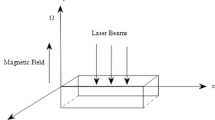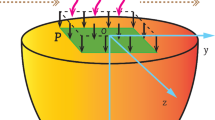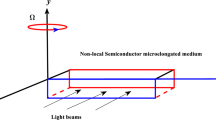Abstract
The manuscript provides a thorough solution for the propagation of waves in a generalized homogeneous and isotropic thermo-photo-electric semiconductor medium. The main focus lies in the analysis of the two-dimensional (2D) issue in the presence of a magnetic field while adding optoelectronic excitation mechanisms. The governing equations exhibit coupling and encompass multiple factors, including relaxation time and porosity (voids) parameters. The governing equations are solved utilizing the normal mode technique, resulting in equations for the quasi-static electric field, heat conduction, carrier density (plasma waves), elastic waves, and the constitutive relationships of the thermo-magneto-photo-electric medium. This investigation considers the boundary conditions of plasma, thermal, and mechanical stress to determine the main physical variables involved. The objective of this research is to examine the effects of several thermo-magneto-photo-electric models, characteristics related to porous structures (voids), as well as time and spatial coordinates on a range of physical quantities. The impacts are examined through the visual analysis of graphical representations.


Similar content being viewed by others
REFERENCES
D. Hasselman and R. Heller, Thermal Stresses in Severe Environments (Plenum Press, New York, 1980).
H. Youssef, “State-space on generalized thermoelasticity for an infinite material with a spherical cavity and variable thermal conductivity subjected to ramp-type heating,” J. CAMQ Appl. Math. Inst. 13 (4), 369–390 (2005).
H. Youssef and A. El-Bary, “Thermal shock problem of a generalized thermoelastic layered composite material with variable thermal conductivity,” Math. Probl. Eng. 2006, 87940 (2006). https://doi.org/10.1155/MPE/2006/87940
H. Youssef and I. Abbas, “Thermal shock problem of generalized thermoelasticity for an infinite long annular cylinder with variable thermal conductivity,” Comput. Methods Sci. Technol. 13 (2), 95–100 (2007). https://doi.org/10.12921/cmst.2007.13.02.95-100
D. Todorović, P. Nikolić, and A. Bojičić, “Photoacoustic frequency transmission technique: electronic deformation mechanism in semiconductors,” J. Appl. Phys. 85, 7716–7726 (1999). https://doi.org/10.1063/1.370576
J. Gordon, R. Leite, R. S. Moore, et al., “Long-transient effects in lasers with inserted liquid samples,” J. Appl. Phys. 36, 3–8 (1965). https://doi.org/10.1063/1.1713919
L. Kreuzer, “Ultralow gas concentration infrared absorption spectroscopy,” J. Appl. Phys. 42, 2934–2943 (1971). https://doi.org/10.1063/1.1660651
A. Tam, “Photoacoustic: spectroscopy and other applications,” in Ultrasensitive Laser Spectroscopy, Ed. by D. S. Kliger (Academic Press, New York, 1983), pp. 1–108.
A. Tam, “Applications of photoacoustic sensing techniques,” Rev. Mod. Phys. 58, 381–431 (1986).
A. Tam, “Overview of photothermal spectroscopy,” in Photothermal Investigations in Solids and Fluids (Academic Press., Boston, 1989), pp. 1–34. https://doi.org/10.1016/B978-0-12-636345-6.50005-0
A. Rosencwaig, J. Opsal, W. L. Smith, and D. L. Willenborg, “Detection of thermal waves through optical reflectance,” Appl. Phys. Lett. 46, 1013 (1985). https://doi.org/10.1063/1.95794
J. Opsa and A. Rosencwaig, “Thermal wave depth profiling: theory,” J. Appl. Phys. 53, 4240–8 (1982).
Y. Song, D. Todorovic, B. Cretin, et al., “Study on the generalized thermoelastic vibration of the optically excited semiconducting micro- cantilevers,” Int. J. Solids Struct. 47, 1871–1885 (2010).
Kh. Lotfy and M. Gabr, “Response of a semiconducting infinite medium under two temperature theory with photothermal excitation due to laser pulses,” Opt. Laser Technol. 97, 198–208 (2017). https://doi.org/10.1016/j.optlastec.2017.06.021
Kh. Lotfy, R. Kumar, W. Hassan, and M. Gabr, “Thermomagnetic effect with microtemperature in a semiconducting photothermal excitation medium,” Appl. Math. Mech. Eng. Ed. 39 (6), 783–796 (2018). https://doi.org/10.1007/s10483-018-2339-9
M. Marin and G. Stan, “Weak solutions in elasticity of dipolar bodies with stretch,” Carpathian J. Math. 29 (1), 33-40 (2013).
B. Straughan, “Stability and uniqueness in double porosity elasticity,” Int. J. Eng. Sci. 65, 1–8 (2013). https://doi.org/10.1016/j.ijengsci.2013.01.001
I. Abbas and M. Marin, “Analytical solutions of a two-dimensional generalized thermoelastic diffusions problem due to laser pulse,” Iranian J. Sci. Technol. Trans. Mech. Eng. 42 (1), 57–71 (2018). https://doi.org/10.1007/s40997-017-0077-1
M. Othman, R. Tantawi, and E. Abd-Elaziz, “Effect of initial stress on a thermoelastic medium with voids and microtemperatures,” J. Porous Media 19 (2), 155–172 (2016). https://doi.org/10.1615/JPorMedia.v19.i2.40
S. Cowin and J. Nunziato, “Linear theory of elastic materials with voids,” J. Elasticity 13, 125–147 (1983). https://doi.org/10.1007/BF00041230
R. Dhaliwal and J. Wang, “Domain of influence theorem in the theory of elastic materials with voids,” Int. J. Eng. Sci. 32 (11), 1823–1828 (1994). https://doi.org/10.1016/0020-7225(94)90111-2
A. Saeed, Kh. Lotfy, and M. Ahmed, “Magnetic field influence of photo-mechanical-thermal waves for optically excited microelongated semiconductor,” Math. 10 (23), 4567 (2022). https://doi.org/10.3390/math10234567
S. Mondal and A. Sur, “Photo-thermo-elastic wave propagation in an orthotropic semiconductor with a spherical cavity and memory responses,” Waves Rand. Complex Media 31 (6), 1835–1858 (2021). https://doi.org/10.1080/17455030.2019.1705426
S. El-Sapa, M. Mohamed, Kh. Lotfy, et al. “A mechanical ramp type of electron–hole semiconducting model with laser pulses and variable thermal conductivity,” Acta Mech. 233, 4641–4658 (2022). https://doi.org/10.1007/s00707-022-03342-z
A. Mahdy, “Stability, existence, and uniqueness for solving fractional glioblastoma multiforme using a Caputo–Fabrizio derivative,” Math. Meth. Appl. Sci. 1–18 (2023). https://doi.org/10.1002/mma.9038
A. Zenkour and I. Abbas, “Nonlinear transient thermal stress analysis of temperature-dependent hollow cylinders using a finite element model,” Int. J. Struct. Stab. Dyn. 14 (7), 1450025 (2014). https://doi.org/10.1142/S0219455414500254
D. Todorović, P. Nikolić, and A. Bojičić, “Photoacoustic frequency transmission technique: electronic deformation mechanism in semiconductors,” J. Appl. Phys. 85, 7716–7726 (1999). https://doi.org/10.1063/1.370576
L. Zelenyi and A. Milovanov, “Fractal topology and strange kinetics: from percolation theory to problems in cosmic electrodynamics,” Fiz. Usp. 174 (8), 749–788 (2004). https://doi.org/10.1070/PU2004v047n08ABEH001705
V. Filatov, “On some inverse problems in fractal medium,” in Int. Conf. “Inverse and Ill-Posed Problems of Mathematical Physics”, Novosibirsk, Russia, August, 20-25 (Novosibirsk, 2007).
M. Ciesielski and J. Leszczynski, “Numerical solutions to boundary value problem for anomalous diffusion equation with Riesz-Feller fractional operator,” J. Theor. Appl. Mech. 44 (2), 393–403 (2006).
W. Chen and S. Holm, “Fractional laplacian timespace models for linear and nonlinear lossy media exhibiting arbitrary frequency dependency,” J. Acoust. Soc. Am. 115 (4), 1424–1430 (2004). https://doi.org/10.1121/1.1646399
S. Hosseini, J. Sladek, and V. Sladek, “Nonlocal coupled photo-thermoelasticity analysis in a semiconducting micro/nano beam resonator subjected to plasma shock loading: A Green-Naghdi-based analytical solution,” App. Math. Modell. 88, 631–651 (2020). https://doi.org/10.1016/j.apm.2020.06.069
S. Hosseini and C. Zhang, “Plasma-affected photo-thermoelastic wave propagation in a semiconductor Love–Bishop nanorod using strain-gradient Moore–Gibson–Thompson theories,” Thin-Walled Struct. 179, 109480 (2022). https://doi.org/10.1016/j.tws.2022.109480
M. Ezzat and H. Youssef, “A thermal and thermal stress analysis in thermoelectric solid under the influence of thomson effect,” J. Thermoelast. 1 (2), 4–121 (2013).
A. Mandelis, M. Nestoros, and C. Christofides, “Thermoelectronic-wave coupling in laser photothermal theory of semiconductors at elevated temperatures,” Opt. Eng. 36 (2), 459–468 (1997). https://doi.org/10.1117/1.601217
H. Yépez-Martínez, J. Gómez-Aguilar, and D. Baleanu, “Beta-derivative and sub-equation method applied to the optical solutions in medium with parabolic law nonlinearity and higher order dispersion,” Optics 155, 357–65 (2018). https://doi.org/10.1016/j.ijleo.2017.10.104
Kh. Lotfy, “A novel model for photothermal excitation of variable thermal conductivity semiconductor elastic medium subjected to mechanical ramp type with two-temperature theory and magnetic field,” Sci. Rep. 9, 3319 (2019). https://doi.org/10.1038/s41598-019-39955-z
A. Rasheed and M. Anwar, “Interplay of chemical reacting species in a fractional viscoelastic fluid flow,” J. Mol. Liq. 273, 576–588 (2019). https://doi.org/10.1016/j.molliq.2018.10.028
C. Christofides, A. Othonos, and E. Loizidou, “Influence of temperature and modulation frequency on the thermal activation coupling term in laser photothermal theory,” J. Appl. Phys. 92, 1280–1289 (2002). https://doi.org/10.1063/1.1484232
A. Hobiny and I. Abbas, “A GN model on photothermal interactions in a two-dimensions semiconductor half space,” Results Phys. 15, 102588 (2019). https://doi.org/10.1016/j.rinp.2019.102588
J. Liu, M. Han, R. Wang, et al., “Photothermal phenomenon: Extended ideas for thermophysical properties characterization,” J. Appl. Phys. 131, 065107 (2022). https://doi.org/10.1063/5.0082014
H. Youssef and A. El-Bary, “Two-temperature generalized thermoelasticity with variable thermal conductivity,” J. Thermal Stress. 33, 187–201 (2010). https://doi.org/10.1080/01495730903454793
A. M. S. Mahdy, M. S. Mohamed, Kh. Lotfy, et al., “Numerical solution and dynamical behaviors for solving fractional nonlinear Rubella ailment disease model,” Results Phys. 24, 104091 (2021). https://doi.org/10.1016/j.rinp.2021.104091
A. M. S. Mahdy, Kh. Lotfy, and A. El-Bary, “Use of optimal control in studying the dynamical behaviors of fractional financial awareness models,” Soft Comput. 26, 3401–3409 (2022). https://doi.org/10.1007/s00500-022-06764-y
A. M. S. Mahdy, K. Gepreel, Kh. Lotfy, and A. El-Bary, “A numerical method for solving the Rubella ailment disease modelþ,” Int. J. Modern Phys C 32 (07), 2150097 (2021). https://doi.org/10.1142/S0129183121500972
ACKNOWLEDGMENTS
The authors extend their appreciation to Princess Nourah bint Abdulrahman University for fund this research under Researchers Supporting progect no. (PNURSP2023R154) Princess Nourah bint Abdulrahman University, Riyadh, Saudi Arabia.
Funding
This work was supported by ongoing institutional funding. No additional grants to carry out or direct thisparticular research were obtained.
Author information
Authors and Affiliations
Corresponding authors
Ethics declarations
The authors of this work declare that they have no conflicts of interest.
Additional information
Publisher’s Note.
Allerton Press remains neutral with regard to jurisdictional claims in published maps and institutional affiliations.
APPENDIX
APPENDIX
The primary variables of Eqs. (20)–(35) can be represented as
The main parameters in Eqs. (64–71) can be expressed as
Calculating the values of the fundamental coefficients in equation (36), which can be done with software like Mathematica and Matlab, is as simple as doing the following
About this article
Cite this article
Raddadi, M.H., El-Sapa, S., Saeed, A.M. et al. Influence of Magnetic Field on Thermomechanical Optical Waves in a Semiconductor Medium with Porosity. Mech. Solids 58, 3162–3176 (2023). https://doi.org/10.3103/S0025654423601994
Received:
Revised:
Accepted:
Published:
Issue Date:
DOI: https://doi.org/10.3103/S0025654423601994




